On our maps, we located a tourist office in Grand Place, and headed that direction. At the tourist office, I inquired (in French) from which station do trains leave for Bruges. The agent told me that trains for Bruges left from Gare du Midi, the train station at which we had arrived from Paris. Using the walking tours of Brussels in our guidebook, we checked out the heart of Brussels and then Sablons, through sprinkles and through heavier rain.
On our maps, we located a tourist office in Grand Place, and headed that direction. At the tourist office, I inquired (in French) from which station do trains leave for Bruges. The agent told me that trains for Bruges left from Gare du Midi, the train station at which we had arrived from Paris. Using the walking tours of Brussels in our guidebook, we checked out the heart of Brussels and then Sablons, through sprinkles and through heavier rain.

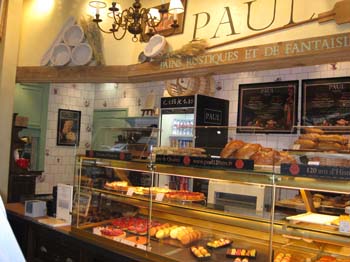
The gilded architecture in Grand Place is quite a treat. The Hotel de Ville sports a spire built in 1449 and 315 feet high and anchors the cobblestone square. The square is the geographical, historical and commercial heart of Brussels and hosted open air markets as far back as the 11th century, now home to a flower market. After the town hall was built, the guild houses making up the sides of the square were built by city merchants and traders. Only the town hall and two guild houses survived the cannonball bombing by the French in 1695. Trade guilds were encouraged to rebuild their halls to styles approved by the Town Council (sort of I imagine like Richmond’s Commission of Architectural Review) and the end result is a unified collection of Flemish Renaissance buildings. The square’s structures include the Maison du Roi (once the residence of ruling Spanish monarchs, now the home of the Musee de Ville), Le Pigeon (once home to Victor Hugo), La Maison des Ducs de Brabant (a group of 6 guild houses with stone busts of the dukes along the facade), a statue of Everhard’t Sercleas (who died defending Brussels in the 14th Century – touching his arm is said to bring luck), Le Renard (built in 1690’s as the guild house of haberdashers with St Nicholas patron saint of merchants on the front), Le Cornet (the boatmen’s guild house with its gable in the form of a 17th century frigate bow) , and La Maison des Boulangers (built by the wealthy and powerful bakers guild, it is topped by a 1676 octagonal copper dome topped by a dancing gold figure).
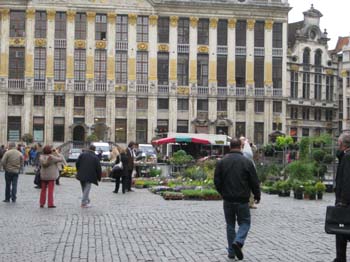


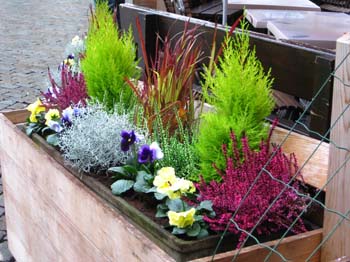
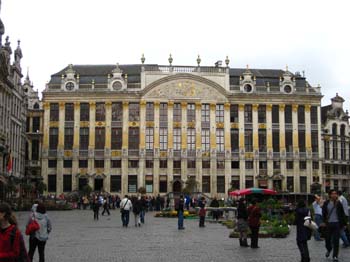

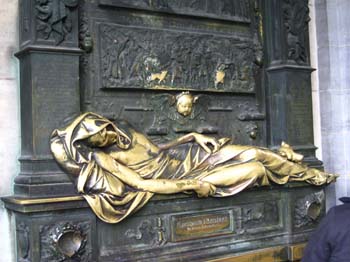

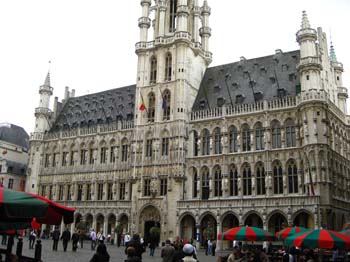

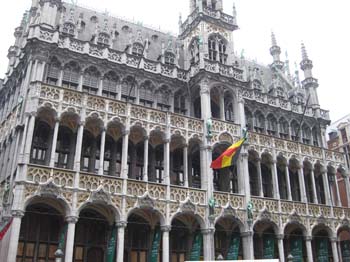
We left the square on the Rue au Beurre, passed the Biscuiterie Dandoy (at no. 31 famous for its buttery biscuits). We visited Eglise St-Nicholas, severely damaged in 1695 by a cannonball lodged in an interior pillar which collapsed the belltower in 1714. Rebuilt in 1956, the west façade was given a new gothic-style façade. The church contains choir stalls dating from 1381 displaying detailed medallions telling the story of St-Nicholas and art work by Peter Paul Rubens. Legend goes that the chapel was constructed at an angle to avoid the flow of an old stream. Evidently while the church was abandoned, merchants constructed shops against the exterior walls.
We double-backed a short way to check out La Bourse – Brussels’ stock exchange. It is the only building on its block giving it an impressive presence and was designed in Palladian-style. It has ornate carvings on the façade; with Auguste Rodin rumored to have carved groups representing Africa and Asia, as well as four caryatids inside. Once the site of frenzied trading, all trading is now computerized.
buy Lyrica online uk
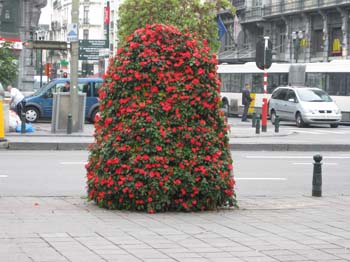
Going down the left side of La Bourse, on Rue Henri Maus, we located Falstaff, one of the few Art Nouveau cafes left in Brussels – dating to 1903. Crossing over Boulevard Anspach, we read in our guidebook that the boulevard was once the route of the river Senne, which was canalized and then covered in 1870. The entire area was marshland when settled in 7th century, and “Broucsella†meant settlement in the marshes.
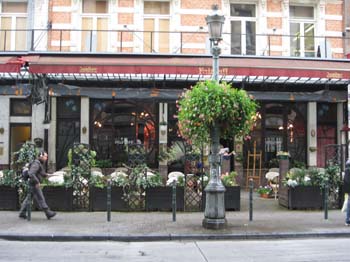
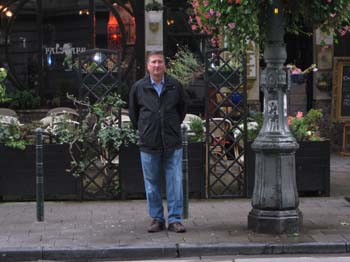
We continued on to Halles St-Gery – formerly the old meat market that covered the entire Place st-Gery. It is now a hip new restaurant. The square was an island until the mid-19th century and the River Senne still runs beneath. Across from the market, in the courtyard of a renovated apartment (23 Place St-Gery), we could see some of the river.

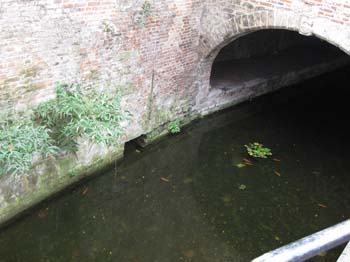
We left the square on Rue Antoine Dansart toward Place Ste-Catherine. Only the Baroque Tower on the Eglise Ste-Catherine remains from the original church built in 15th century. The current church, inspired by St-Eustache in Paris, was redesigned in 1854-59. Inside it houses the Black Madonna, a portrait of St. Catherine, and a typical Flemish pulpit.
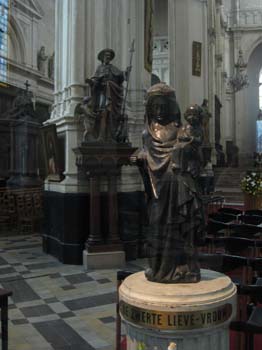
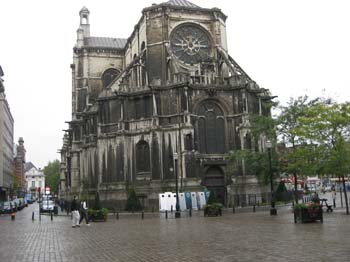
Just outside to the east is the Black Tower, a surviving remnant of the 12th century stone city walls. Walking around the rear of Ste-Catherine’s, we came to a broad open space lined by Quai au Bois a Bruler (firewood) and Quai aux Briques (bricks). The area between, once a canal, was covered over in 1870 and became the fish market. Now filled with fountains and pools, and surrounded by fish restaurants, the central area is filled with umbrellas and tables for dining in temperate weather. We vowed to return her for dinner tonight!
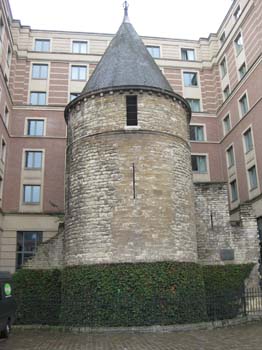

Rue de Peuplier took us to Eglise St-Jean-Baptiste-au-Beguinage. This stone-clad church was consecrated in the 17th century to serve the long-standing and largest beguine community. Fields and orchards previously surrounded the site and contained cottages and houses for the 1200 beguine women, members of a lay religious order who joined after widowhood or failed marriages. In medieval times, the beguines ran a laundry, hospital, and windmill for the city. buy Lurasidone tablets Â
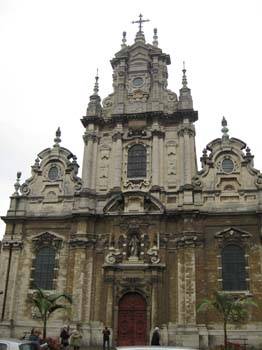

We headed on toward the Place De Brouckere, where in 1872 a design competition was held to construct the buildings here. 20 winning applicants were allowed to surround the square with their buildings. Many of the buildings are of stone (common in France, whereas brick is more common in Belgium) and includes the Hotel Metropole (fabulous 1900-1910 Art Nouveau interior, visited by notables including Sarah Bernhardt, Marie Curie, and Albert Einstein). In the 1960’s two buildings with predominantly glass facades brought contemporary architecture into the varied historic architecture of the square. The huge lighted Coca-Cola sign on top of one of the neo-Classical buildings is enough to make one be ashamed to be an American.
Back through Passage Nord, to Rue Neuve to Place Des Martyrs. In the center of this remarkably quiet square is a marble statue of Belga under which is a mausoleum for the 450 martyrs killed in the 1830 revolution that secured Belgium its independence and installed Leopold 1 as king. At one end of this square is the seat of the Flemish government.

Retracing our way Rue Neuve we continued up to Place de la Monnaie. Most traces of the statue we saw our first night are now gone, so obviously the Three Legged Buddha is leaving not arriving.
Walking on Rue L’Ecuyer we came to the entrance of Galeries St-Hubert, a shopping arcade dating to 1847 (this is the first in Europe and one of the most elegant). The vaulted glass roof covers three sections, Galerie du Roi, Galerie de la Reine, and Galerie des Princes. In the 19th century this was the fashionable meeting place for society. Today, the shops feature expensive goods and luxury shopping and restaurants.
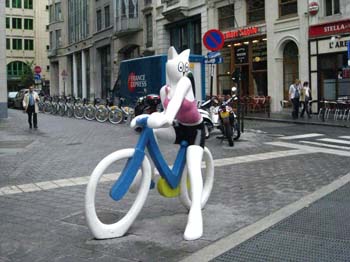


Halfway along, the gallery is intersected by the pedestrianized Rue des Bouchers. This area was designated the Ilot Sacre back in 1960 to protect it from development. Just off Rue des Bouchers is the Petit Rue des Bouchers and halfway down on the left is an alley called the Impasse, housing Brussels’ famous historic puppet theater.
Back to Grand Place to start our second tour, this time of Brussels’ Marolles area. We left the Grand Place via Rue Charles Buls, passing tapestry and lace and tourist shops galore.  Musee du Costume and Dentelle (lace) on Rue de la Violette was closed and we’ll come back another day. Continuing on Rue de l’Etuve to Rue de Chene, we found the famous statue/fountain Manneken Pis. This little fountain statue has 650 costumes on display in the Musee de Ville. The original was installed in 1691 – a tongue-in-cheek design reflecting a genuine need for fresh drinking water. It was stolen and broken in 1817 and a replica was cast and returned to its site the following year.   His “sister†Jeannke Pis a cheeky female version was installed in 1987 in Impasse de la Fidelite off Rue de Bouchers in the spirit of sexual equality. We had seen it our first night, but didn’t realize it’s relation to the other
fountain.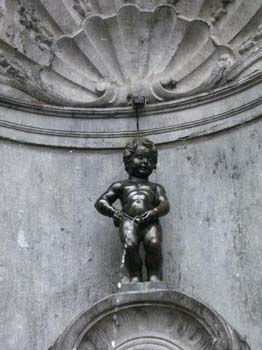 Up the Rue de Chene to Rue de Villers, to find the Tour Villiers, the remains of a tower and section of the 12th century walls surrounding the city. Even though it was raining hard now, we continued on to the church of Notre-Dame de la Chappelle. A chapel was built on the site in 1134, it became a pilgrimage site after 1250 when a royal donation of five pieces of the True Cross turned it into a pilgrimage site. Much of the church was destroyed by fire in 1405; rebuilding began in 1421. Exterior features monstrous gargoyles peering down on the neighborhood. Across from the church is a city-maintained skateboard park.
Up the Rue de Chene to Rue de Villers, to find the Tour Villiers, the remains of a tower and section of the 12th century walls surrounding the city. Even though it was raining hard now, we continued on to the church of Notre-Dame de la Chappelle. A chapel was built on the site in 1134, it became a pilgrimage site after 1250 when a royal donation of five pieces of the True Cross turned it into a pilgrimage site. Much of the church was destroyed by fire in 1405; rebuilding began in 1421. Exterior features monstrous gargoyles peering down on the neighborhood. Across from the church is a city-maintained skateboard park.
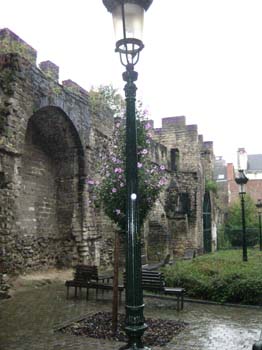
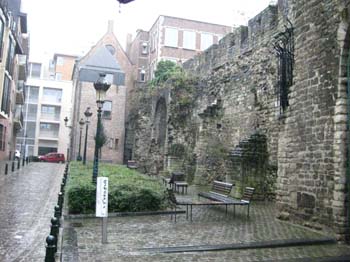

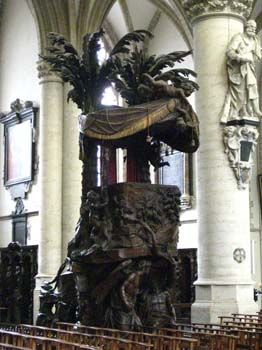
Still pouring, we continued south into the neighborhood known as Quartier Marolles, situated between the two city walls, home to weavers and craftsmen. Following streets not on our tour, we found antique and brocante shops, furniture stores, and even fabric stores.
Weaving around the streets, we found Place du Grand Sablon, dividing upper and lower Brussels. The fountain in the middle of the square was funded by an Englishman; the square is surrounded by elegant townhouses and, even in the rain, seems to be a chic part of Brussels. At No. 12 we found, Wittamer, supposedly one of Brussels’ most celebrated chocolate makers – but there wasn’t a lot of chocolate around when we were there.
The rain was driving us back toward a rest stop, we abandoned the tour and headed for Cathedrale Sts Michel et Gudule, passing the national library, rose gardens and the equestrian statue of Albert 1, the “soldier king†who led troops into World War 1
.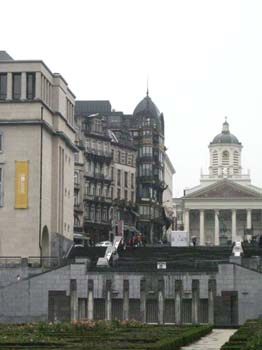
The cathedral was immense and featured a stained glass window called the “Last Judgement,†highly ornate baroque pulpit, statue of St Michael (Mike’s namesake since he was born in St Michael’s Hospital and his mother couldn’t come up with a name until she was ready to leave the hospital and they demanded one for his birth certificate), and a statue of Ste-Gudule, a saint dear to people of Brussels. The twin towers of the front of the cathedral were very reminiscent of those of Notre-Dame in Paris. The crypt contains remnants of the first church on the site dating from 1047; some can be seen through a grate in the floor of the cathedral.
Sopping wet, we headed back toward the Grand Place and a cup of hot chocolate and our first Belgian waffle. Then back to the hotel to plan for dinner. Our plan for dinner at the location of the old fishmarket by Ste-Catherine’s went awry when we started checking out menus. The prices were very high and even the prix fixe menus were high. Realizing our Belgian waffle earlier had left its mark and neither of us was hungry enough to spend 50-60 euros each on dinner, we wandered back to Rue de Bouchers and found Luna di Venezia where Mike could have mussels and I had a grilled sea bream fillet with a dijonnaise sauce and we split some house red wine.
On our way back to the hotel, we wandered through Grand Place to see it lighted up at night.  Even in the rain it was a busy place. At Place du Monnaie, the statue and all of its remnants were gone.

